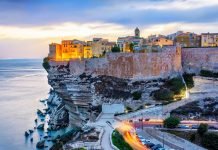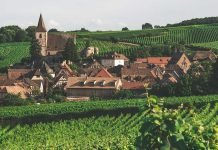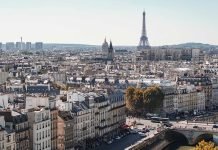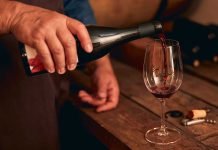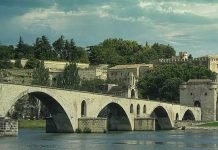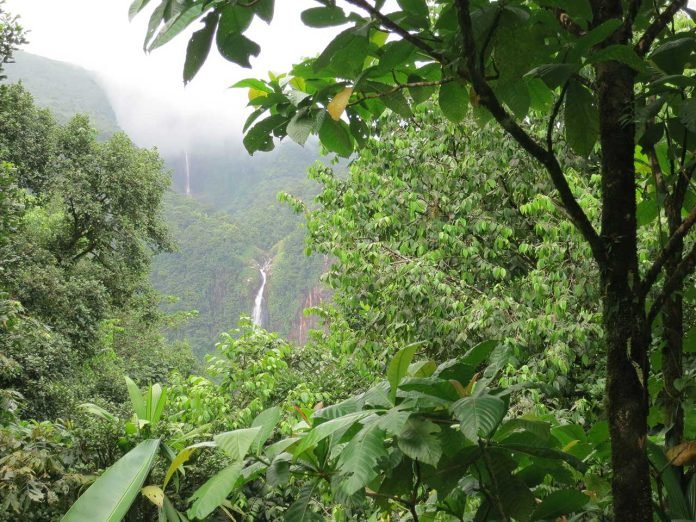The island of Basse-Terre, located in the Guadeloupe archipelago in the Caribbean, is a haven for nature enthusiasts and the location of the Guadeloupe National Park. The lush rainforests of Basse-Terre, which cover a large portion of the island, offer a rich and dynamic environment. In this article we set out to discover the unique flora and fauna of Basse-Terre Island, it’s rivers and waterfalls and the rewarding, whilst occasionally challenging, hikes and walks. We will conclude by discussing conservation, the cultural significance of the island and the local climate conditions that you can look forward to.
Biodiversity and Wildlife:
The rainforests of Basse-Terre are a biodiversity hotspot, where every corner holds the promise of a new discovery. The rich, vibrant ecosystem thrives due to the island’s isolated location, varied topography, and tropical climate.
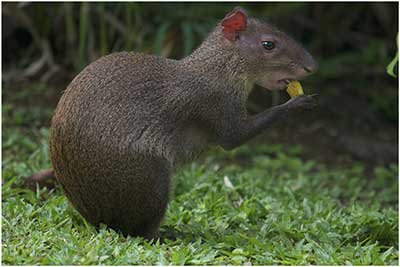
Agoutis, agile and alert, are one of the common mammals spotted in these forests. They play a vital role in seed dispersal, particularly large seeds that few other animals can manage, thereby assisting in the regeneration of the forest. The Guadeloupe raccoon is another significant mammal, and its behavior and ecology are adapted perfectly to island life, making it a fascinating subject for naturalists.
Bats are crucial in these ecosystems, serving as pollinators for various plants and helping to control insect populations. The sight of a bat swooping gracefully through the twilight is a regular and enchanting part of forest life in Basse-Terre.
Reptiles and amphibians also abound, from the dainty anoles that flit through the understory to the larger, more elusive species. These creatures, often overlooked, are fundamental to the health of the ecosystem, acting as both predator and prey in a complex food web. Some of the species include, Pholidoscelis cineraceus, known for its oviparous reproduction and Eleutherodactylus pinchoni, a species of small frogs found in the area.
Flora:
In the forests of Basse-Terre, one can wander beneath ancient trees that have stood for centuries, their trunks gnarled and massive, and their canopies filtering the golden Caribbean sunlight into a dappled tapestry that plays across the forest floor.
Giant tree ferns, relics from an ancient world, are so emblematic of the forest that they have become a symbol of the island’s wild spaces. Their arching fronds create a unique microhabitat for a host of smaller organisms, from insects to epiphytic plants.
Orchids in Basse-Terre are an epitome of tropical beauty, with their intricate forms and vibrant colors. In the wild, they often grow as epiphytes, clinging to the trunks and branches of trees and drawing nutrients not from the soil but from the air and rainwater. They are a testament to the incredible adaptability and diversity of life in the tropics.
Mahogany trees, once heavily exploited for their valuable timber, are now a treasured and protected part of the landscape. These trees are a living testament to the island’s history, and their continued presence is a symbol of successful conservation efforts.
Gommier trees are also notable, their resin has been historically used by the indigenous people to waterproof their boats (called Gommiers), and their wood is known to be hard and durable.
Beneath the high canopy, the understory is a world unto itself. Here, medicinal plants, recognized by the island’s first inhabitants and still used today, thrive. Knowledge of these plants and their uses is a deeply ingrained part of local culture. For example, certain roots are brewed into tonics, and various leaves are used in poultices. These practices are not merely historical; they are a living tradition that continues to be passed down through generations.
In summary, the rainforests of Basse-Terre are a thriving, living entity. Every layer, from the high canopy to the forest floor, is teeming with life. This lush and vibrant environment, shaped by centuries of growth and adaptation, is a jewel of the Caribbean and a profound example of the Earth’s ability to nurture astonishing diversity. For scientists, conservationists, and nature enthusiasts alike, Basse-Terre stands as both a living laboratory and a sanctuary, offering invaluable insights into the richness and resilience of life.
Rivers and Waterfalls:
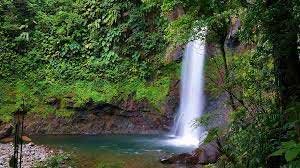
The rainforests of Basse-Terre are like a living, breathing water feature, with rivers and streams that traverse the landscape, giving life to all they touch. Among these, the Chutes du Carbet stand out. These three waterfalls, set against the backdrop of the majestic La Soufrière volcano, are an iconic natural landmark. The tallest of the waterfalls drops from a height of 125 meters, making it a mesmerizing sight. Alongside Chutes du Carbet, numerous other waterfalls dot the island, such as Cascade aux Écrevisses—a smaller but equally enchanting waterfall that is easily accessible. These rivers and falls are not just stunning to behold; they are also pristine and pure, offering visitors the chance to cool off in translucent, invigorating pools surrounded by lush forest.
Hiking and Eco-Tourism:
Basse-Terre is a hiker’s paradise, with trails that offer something for every level of experience and fitness. Families can enjoy leisurely walks through coastal mangroves, while more adventurous souls can embark on challenging treks that lead through the heart of the montane rainforests. The Parc National de la Guadeloupe is the epicenter of eco-tourism on the island. The park is meticulously maintained, with clearly marked trails that vary in difficulty. Visitor centers within the park offer detailed information and sometimes guided tours, which are led by knowledgeable guides who can share the intricate details of the ecosystem, ensuring visitors have both a safe and enlightening experience.
Conservation Efforts:
Basse-Terre’s rainforests are a globally significant natural treasure, and they are treated as such. The Parc National de la Guadeloupe plays a critical role in preserving this environment. Established in 1989, the park serves not just as a protective boundary but as a hub of research, education, and community engagement. The park’s staff work diligently to monitor and manage the ecosystem, protect endangered species, and restore areas that have been impacted by human activities or natural events. They also offer environmental education programs aimed at fostering a sense of stewardship in both locals and visitors alike.
Cultural Significance:
For centuries, the rainforests of Basse-Terre have been more than just a landscape; they have been a way of life. The indigenous Kalinago people, and later the Creole population, developed deep, symbiotic relationships with these forests. From the trees, they crafted their boats and homes, and from the plants, they derived medicines, dyes, and spiritual practices. Many of these traditions continue today, serving as a vibrant link between the people and their environment. The forests are not just physically nurturing; they are spiritually and culturally nurturing, continuing to play a vital role in the island’s identity.
Climate and Best Time to Visit:
Basse-Terre enjoys a tropical climate, characterized by warmth and humidity year-round. From June to October, the island experiences its wetter season, which coincides with the Caribbean hurricane season. From November to May, the climate tends to be cooler and less humid, offering a more comfortable environment for hiking and exploring. This dry season is generally regarded as the best time to visit, as the trails are less slippery, the risk of rain is lower, and the temperatures are more conducive to outdoor activities.
The lush rainforests of Basse-Terre in Guadeloupe are a naturalist’s dream but are also a vibrant, living testament to the intricate relationship between humanity and nature, filled with history, culture, and unmatched biodiversity. Every river, trail, and tree tells a story—a story of nature’s grandeur, of deep cultural roots, and of a future that is being carefully, lovingly crafted through thoughtful conservation. It’s a living classroom for eco-tourists, a haven for adventurers, and a sacred space for the people who call this island home.

